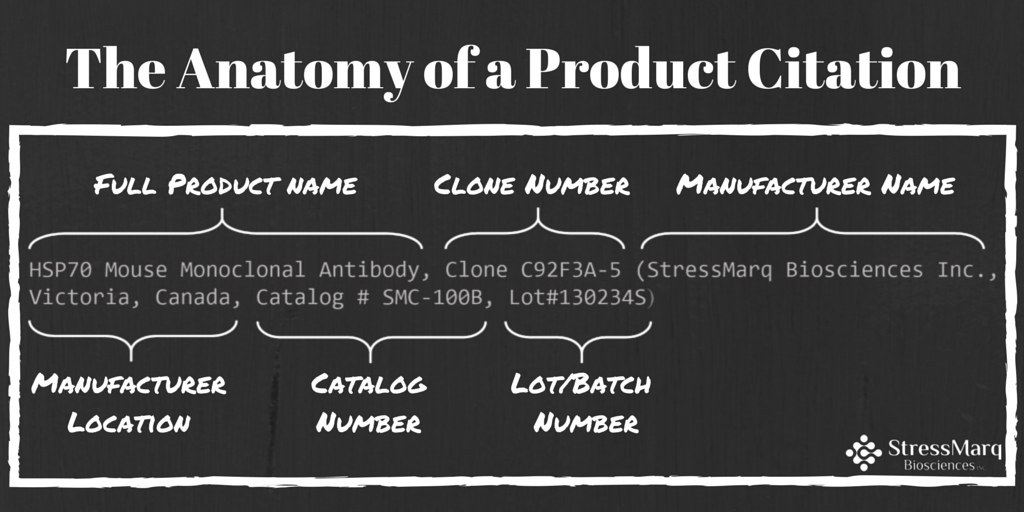How to Cite a Product
Originally published by StressMarq Biosciences Mar 2015 | Updated July 2025
Updated: July 18, 2025
Properly citing scientific products such as antibodies, proteins, and small molecules is essential for reproducibility and transparency in research. This guide outlines how to cite products in your publications and introduces updated best practices including the use of RRIDs (Research Resource Identifiers).
Why Cite a Product?
Citing the exact product used in your research allows others to replicate your experiments and ensures that suppliers receive proper credit. It also helps reviewers and readers evaluate the reliability of your methods.
Basic Citation Format
When citing a product, include the following information:
- Product name
- Catalog number
- Supplier name
- RRID (if available)
Example:
HSP70 Mouse Monoclonal Antibody, Clone C92F3A-5 (StressMarq Biosciences, Victoria, Canada, Cat. # SMC-100)
What is an RRID?
RRIDs (Research Resource Identifiers) are unique identifiers assigned to research resources such as antibodies, model organisms, and software tools. They help standardize citations and improve reproducibility.
You can find RRIDs for many products by searching the SciCrunch Resource Identification Portal.
How to Find an RRID
- Visit https://scicrunch.org/resources
- Enter the product name or catalog number in the search bar
- Locate the correct product and copy the RRID
Additional Tips
- Always use the most up-to-date product information from the supplier’s website
- Include the RRID in the methods section of your manuscript
- Check journal guidelines for specific citation requirements
Conclusion
Accurate product citation is a small step that makes a big difference in scientific communication. By including RRIDs and supplier details, you contribute to a more transparent and reproducible research ecosystem.
For more information, visit StressMarq Biosciences or explore the SciCrunch RRID Portal.
Original Blog (March 2015)
The number of citations for a specific product has increasingly become the measuring stick for choosing a good quality bioreagent. Scientists want to see whether others have used the product successfully in their specific application or tissue type.
However, researchers themselves are making this metric incredibly inaccurate. Often times, only the manufacturer of a product is cited in a paper. This leaves readers scrambling to determine which product was actually used, potentially looking at hundreds of possibilities.
A recent study found that less than half of researchers provide enough information about an antibody to enable others to find and purchase the same product1.
So what information should you cite in order for fellow researchers to purchase the same product?
We’ve outlined the basics for properly citing antibodies, however the same guidelines can be used for any bioreagent.

Learn how to cite a product correctly by including the following information:
1. Full product name
- HSP70 Mouse Monoclonal Antibody, Clone C92F3A-5
- HSP70 Antibody
2. Manufacturer
- HSP70 Mouse Monoclonal Antibody, Clone C92F3A-5 (StressMarq Biosciences, Victoria, Canada)
- HSP70 Antibody (Stress Marq)
3. Catalog code
- HSP70 Mouse Monoclonal Antibody, Clone C92F3A-5 (StressMarq Biosciences, Victoria, Canada, Cat. # SMC-100)
- HSP70 Mouse Monoclonal Antibody (Stress Marq)
4. Lot/batch number
The lot number is probably the last thing people think to include, however products can vary batch to batch, especially polyclonal antibodies. Therefore including the lot number allows other researchers to ask for the specific batch as well.
- HSP70 Mouse Monoclonal Antibody, Clone C92F3A-5 (StressMarq Biosciences, Victoria, Canada, Cat. # SMC-100, Lot#S130234)
- HSP70 Mouse Monoclonal Antibody (Stress Marq)
The final product citation may seem long, especially if you are using many different products, but in the end you want researchers to be able to find and use the same reagents.
Also be sure to list the product in the appropriate section in your methods section. Fellow researchers need to be able to easily determine what application, species, and tissue type the product was used with.
Now get out there and write some papers with the correct product citations! The research world will thank you!
1. Vasilevsky, N. A. et al. PeerJ 1, e148 (2013).


Leave a Reply